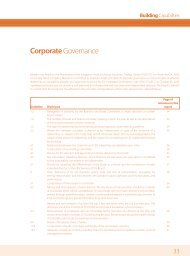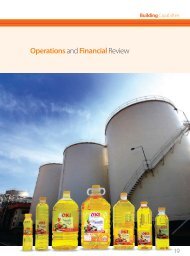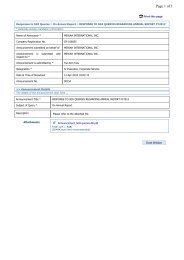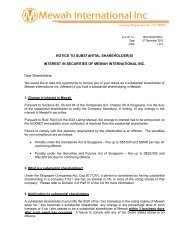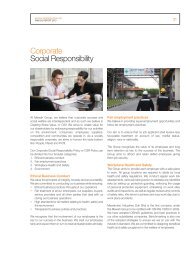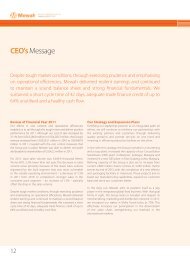Financial Statements - Mewah Group
Financial Statements - Mewah Group
Financial Statements - Mewah Group
You also want an ePaper? Increase the reach of your titles
YUMPU automatically turns print PDFs into web optimized ePapers that Google loves.
Building Capabilities<br />
Notes to the <strong>Financial</strong> <strong>Statements</strong><br />
For the financial year ended 31 December 2011<br />
2. Significant accounting policies (continued)<br />
2.7 Impairment of non-financial assets (continued)<br />
(b)<br />
Property, plant and equipment (continued)<br />
2.8 Borrowing costs<br />
Investments in subsidiaries and associates (continued)<br />
A reversal of impairment loss for an asset other than goodwill is recognised in profit or loss, unless the asset is carried<br />
at revalued amount, in which case, such reversal is treated as a revaluation increase. However, to the extent that an<br />
impairment loss on the same revalued asset was previously recognised as an expense, a reversal of that impairment<br />
is also credited to profit or loss.<br />
Borrowing costs are recognised in profit or loss using the effective interest method except for those costs that are<br />
directly attributable to the acquisition, construction or production of a qualifying assets. Capitalising of borrowing costs<br />
commences when the activities to prepare the asset for its intended use or sale are in progress and the expenditure<br />
and borrowing costs are being incurred. Borrowing costs are capitalised until the assets are ready for their intended<br />
use or sale.<br />
Borrowing costs on general borrowings are capitalised by applying a capitalisation rate to the acquisition, construction<br />
or production of qualifying assets that are financed by general borrowings.<br />
2.9 <strong>Financial</strong> assets<br />
(a)<br />
Classification<br />
The <strong>Group</strong> classifies its financial assets in the following categories: at fair value through profit or loss, loans and<br />
receivables, held-to-maturity, and available-for-sale. The classification depends on the nature of the asset and the<br />
purpose for which the assets were acquired. Management determines the classification of its financial assets at<br />
initial recognition.<br />
(i)<br />
<strong>Financial</strong> assets at fair value through profit or loss<br />
This category has two sub-categories: financial assets held for trading, and those designated at fair value<br />
through profit or loss at inception. A financial asset is classified as held for trading if it is acquired principally<br />
for the purpose of selling in the short term. <strong>Financial</strong> assets designated as at fair value through profit or<br />
loss at inception are those that are managed and their performances are evaluated on a fair value basis,<br />
in accordance with a documented <strong>Group</strong> investment strategy. Derivatives are also categorised as held for<br />
trading unless they are designated as hedges. Assets in this category are presented as current assets if they<br />
are either held for trading or are expected to be realised within 12 months after the statement of financial<br />
position date.<br />
65






